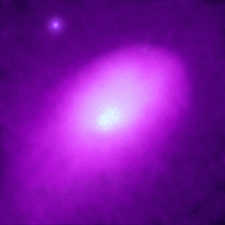Imagine the Universe! News Desk
Colliding Galaxies Create Cosmic "Cold Front"
Chandra X-ray Observatory Maps Pressure Fronts
| 10 April 2000 |
When you think of a cold front, you probably imagine a temperature drop of five or ten degrees. Astronomers and astrophysicists deal with a very different scale. Fifty million degrees may not seem cold to you. But compared to 70 or 100 million degrees, it's quite chilly. Scientist recently mapped a region of those relatively cool temperatures buried inside a large region of colliding galaxies and 70 to 100 million degree gases. It's the first time the pressure fronts in the system have been mapped in detail.
 Chandra X-ray Observatory image of Abell 2142. The image shows a bright, but relatively cool 50 million degree central region (white) embedded in large elongated cloud of 70 million degree gas (magenta), all of which is roiling in a faint atmosphere of 100 million degree gas (faint magenta and dark blue). The bright source in the upper left is an active galaxy in the cluster. |
The gas clouds are in the core of a galaxy cluster known as Abell 2142. The cluster is six million light years across. It contains hundreds of galaxies and enough gas to make a thousand more. It is one of the most massive objects in the universe. Galaxy clusters grow to vast sizes as smaller clusters are pulled inward under the influence of gravity. They collide and merge over the course of billions of years, releasing tremendous amounts of energy that heats the cluster gas to 100 million degrees. The elongated shape of the bright cloud suggests that two clouds were in the process of merging into one.
Data from the Chandra X-ray Observatory provide the first detailed look at the late stages of this merger process. Previously, scientists had used the German-US Roentgen satellite to produce a less detailed image of the cluster. Chandra is currently the world's most powerful x-ray telescope. It's about one billion time more powerful than the first x-ray telescope, created about 30 years ago. Chandra's resolving power is equivalent to the ability to read letters of a stop sign from a distance of 19 kilometers. The observatory is able to measure variations of temperature, density and pressure with unprecedented resolution."Now we can begin to understand the physics of these mergers, which are among the most energetic events in the universe," said Maxim Markevitch of the Harvard-Smithsonian Center for Astrophysics in Cambridge Massachusetts. Mr. Markevitch is the leader of the international team involved in the analysis of the observations. "The pressure and density maps of the cluster show a sharp boundary that can only exist in the moving environment of a merger."
Scientists can compare these images with computer simulations of cosmic mergers. Early results of the comparison show that this merger has progressed to an advanced stage. Strong shock waves predicted by the theory for the initial collision of clusters are not observed. It appears likely that these sub-clusters have collided two or three times in a billion years or more, and have nearly completed their merger.
 An artist rendering of the Chandra X-ray Observatory in orbit |
The observations were made on August 20, 1999 using the Advanced CCD Imaging Spectrometer (ACIS) instrument aboard the Chandra X-ray Observatory. The team involved scientists from Harvard-Smithsonian; the Massachusetts Institute of Technology, Cambridge, Mass.; NASA's Marshall Space Flight Center, Huntsville, Ala.; the University of Hawaii, Honolulu; the University of Birmingham, U.K.; the University of Wollongong, Australia; the Space Research Organization Netherlands; the University of Rome, Italy; and the Russian Academy of Sciences.

